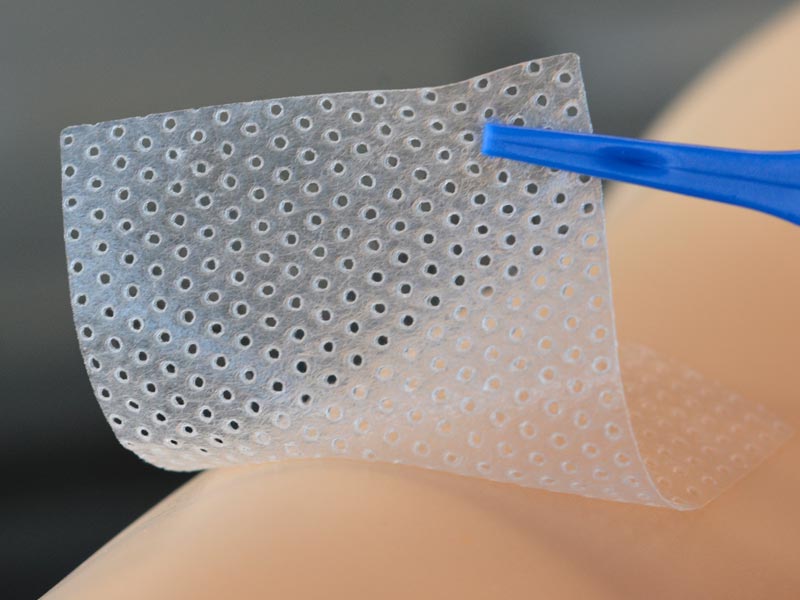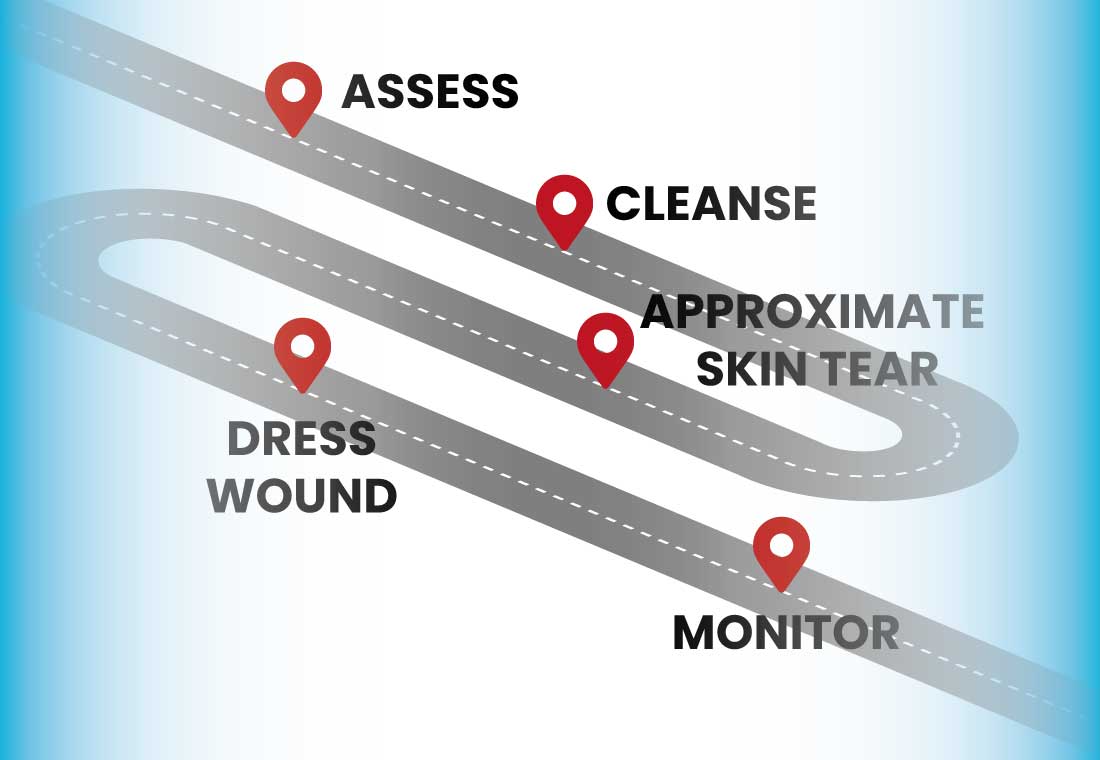Why Use Silicone Dressings for Better Skin Tear Healing?
The International Skin Tear Advisory Panel (ISTAP) recommends silicone dressings for skin tear management. Skin tears occur in people with fragile or ‘paper thin’ skin that is more vulnerable to damage from blunt force, friction, or shear.
Although maintaining skin integrity is the benchmark of wound care, it can be extremely challenging to treat patients with fragile skin or skin tears. This is because even the removal of an adhesive can inflict trauma on the skin and exacerbate any existing wounds.
Silicone dressings were developed to address some of the issues that arise from the use of more conventional wound dressings. This includes minimising pain and trauma during dressing changes, maintaining an adequate moisture balance, protecting the periwound area, promoting comfortable wear, managing exudate, and optimising caregiver time.[1]
What are silicone dressings?
Silicones are synthetic compounds made up of long-chain polymers. They include repeating chains of silicon with other compounds such as oxygen, carbon, and hydrogen. Silicones are widely used in various industries and come in a range of forms, including oils, rubbers, and resins.
Negative reactive reactions to silicones are rare because they have extremely low toxicity levels and cannot be absorbed into the skin.[2]
Silicone dressings have a hydrophobic soft silicone layer that is tacky and does not dry out.
What are the different types of silicone dressings?
Silicone dressings come in various forms, but they are not all created equal when it comes to targeting specific clinical needs. The type of silicone dressing needed will depend entirely on the primary treatment goal, which can range from minimising pain to preventing scarring.[3]
Primary wound contact layers
Primary wound contact layers are typically made from a flexible polyamide mesh that can be comfortably applied while remaining non-adherent to the wound bed. The silicone mesh allows for the passage of fluid into a secondary absorbent dressing, as well as the application of topical treatments. These dressings work best on superficial wounds like burns and skin tears, where minimising pain and leaving the wound bed as undisturbed as possible during the healing process is critical.
Foam dressings with silicone adhesives
Some silicone dressings incorporate an absorbent layer in the centre. The silicone border creates a gentle seal between the dressing and the wound to ensure that any fluid is absorbed into the dressing without leaking out. They are best suited for exuding wounds.
Silicone gel sheets
Silicone gel sheets are designed for healing and closing wounds in a way that reduces scarring. They are usually thicker than more conventional silicone wound contact layers and do not require any secondary dressings.
What are the main benefits of silicone dressings for skin tears?
Skin tears are generally acute wounds that, if cared for correctly, can be expected to heal within the normal wound healing timeframe (approximately 4 weeks). It is important to prioritise maintaining the viability of the flap when selecting a skin tear dressing.[4]
Silicone wound contact layers have several properties and features that make them particularly well suited for skin tear treatment:
1. Silicone adhesives reduce trauma during skin tear dressing changes
Studies show that patients who experience more pain than expected during a procedure can lose trust in clinicians and carers. This often leads to anxiety, stress, and fearfulness.[5]
The type of adhesive used in dressings is one of the most important aspects of skin tear treatment. Unlike dressings with acrylic adhesives, silicone adhesives do not dry out and instead remain tacky. This ensures ease of removal as the silicone adhesive does not stick aggressively to the wound bed.
A study revealed that some silicone dressings removed less skin than some of the more conventional dressings with acrylic adhesives. This means that they may alleviate a significant amount of pain associated with dressing changes.[6]
2. Silicone dressings are flexible and conformable
Skin tears can happen anywhere on the body, including the knees and the elbows. These are parts of the body where there are not only protruding bones, but also increased movement, which can both disturb the position and integrity of a dressing.
Silicone dressings, particularly soft silicone wound contact layers, tend to be made of a thin and flexible mesh. This means that they conform well to the body contours that prove more difficult for foam dressings to adhere to. This ensures comfortable wear in different parts of the body and minimises apulling on the delicate skin around the wound.
3. Silicone dressings enable smart exudate management
All skin tears display varying degrees of tissue damage. In cases where there is blood and exudate, it is important to prevent it from collecting under the flap and minimise leakage into the periwound area.
The porous structure of a silicone wound contact layer allows for exudate to pass through to a secondary dressing and be cleaned easily. This reduces the risk of maceration and infection, and promotes timely healing.
4. Silicone dressings offer transparency
Since the silicone wound contact layers recommended for skin tears are transparent, they allow clinicians to observe and monitor skin tears during wear. This can be done by simply taking off any bandages or secondary dressings that may have been applied to absorb any fluid while ensuring that the flap remains undisturbed.

5. Silicone dressings are cost-effective in the long-term
Healthcare professionals may be reluctant to use silicone dressings in all situations where they are appropriate due to the higher upfront costs they incur. However, using the wrong dressing or a less expensive option that is more widely available may result in complications requiring additional treatments at a greater cost than the initial investment in silicone dressings.
Wound contact layers are considered atraumatic dressings because they reduce pain during dressing removals. This limits the need for anaesthesia or analgesia, which leads to extra costs for healthcare providers.[7]
Silicone adhesives do not dry out, which means that wound contact layers create a protective layer over a skin tear that can stay in place for several days. This significantly reduces the number of dressings used, as well as the time needed for dressing changes.
Silicone wound contact layers help to create an optimal healing environment for skin tears and contribute to faster healing rates, requiring less clinical attention, which ultimately lowers long-term cost implications.[8]
References:
- LeBlanc, Kimberly, Woo, Kevin. A Pragmatic Randomised Controlled Clinical Study to Evaluate the Use of Silicone Dressings for the Treatment of Skin Tears. Int Wound 2022; 19: 126
- Meuleneire, F, Rücknagel, H. Soft Silicone Dressings Made Easy. Wounds International 2013; 1: 1
- Ibid: 1
- Ibid: 1
- Woo K. Wound-Related Pain: Anxiety, Stress and Wound Healing. Wounds UK 2010; 6(4): 92-8
- Meuleneire, F, Rücknagel, H. Soft Silicone Dressings Made Easy. Wounds International 2013; 1: 2
- Ibid: 2
- Ibid: 4
Useful videos:
How to apply & remove dressings
Silicone dressings
Inappropriate dressings
Useful articles:
Why use silicone dressings – Download this article

A skin tear pathway in line with ISTAP recommendations

A guide to the aeitiology, prevalence, prevention, assessment and management of skin tears
Disclaimer:
Please note that while every effort is made to ensure the accuracy of the content presented, it is purely for educational purposes only and is not a substitute for professional medical advice.

